DODGE JOURNEY 2017 1.G Owners Manual
Manufacturer: DODGE, Model Year: 2017, Model line: JOURNEY, Model: DODGE JOURNEY 2017 1.GPages: 510
Page 211 of 510
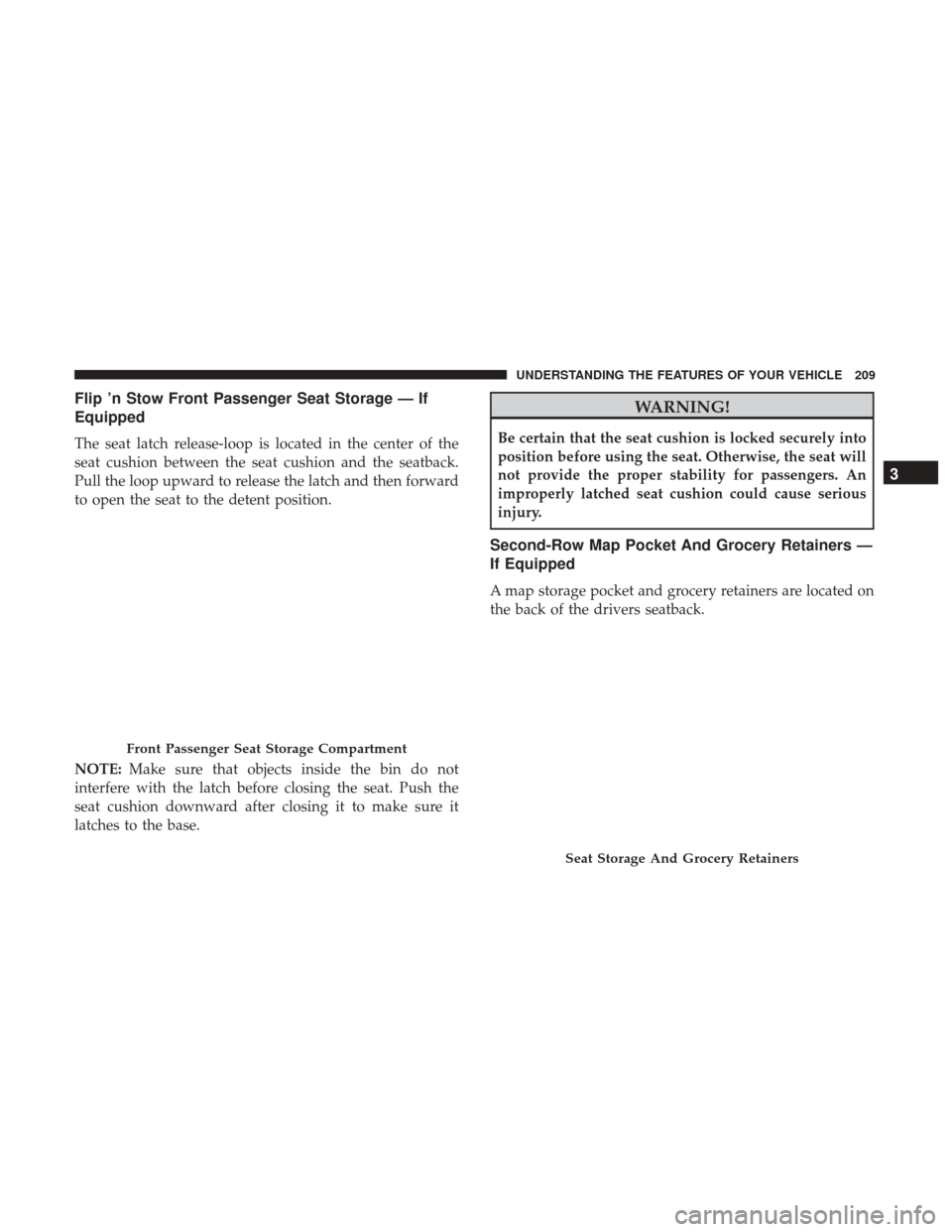
Flip ’n Stow Front Passenger Seat Storage — If
Equipped
The seat latch release-loop is located in the center of the
seat cushion between the seat cushion and the seatback.
Pull the loop upward to release the latch and then forward
to open the seat to the detent position.
NOTE:Make sure that objects inside the bin do not
interfere with the latch before closing the seat. Push the
seat cushion downward after closing it to make sure it
latches to the base.
WARNING!
Be certain that the seat cushion is locked securely into
position before using the seat. Otherwise, the seat will
not provide the proper stability for passengers. An
improperly latched seat cushion could cause serious
injury.
Second-Row Map Pocket And Grocery Retainers —
If Equipped
A map storage pocket and grocery retainers are located on
the back of the drivers seatback.
Front Passenger Seat Storage Compartment
Seat Storage And Grocery Retainers
3
UNDERSTANDING THE FEATURES OF YOUR VEHICLE 209
Page 212 of 510
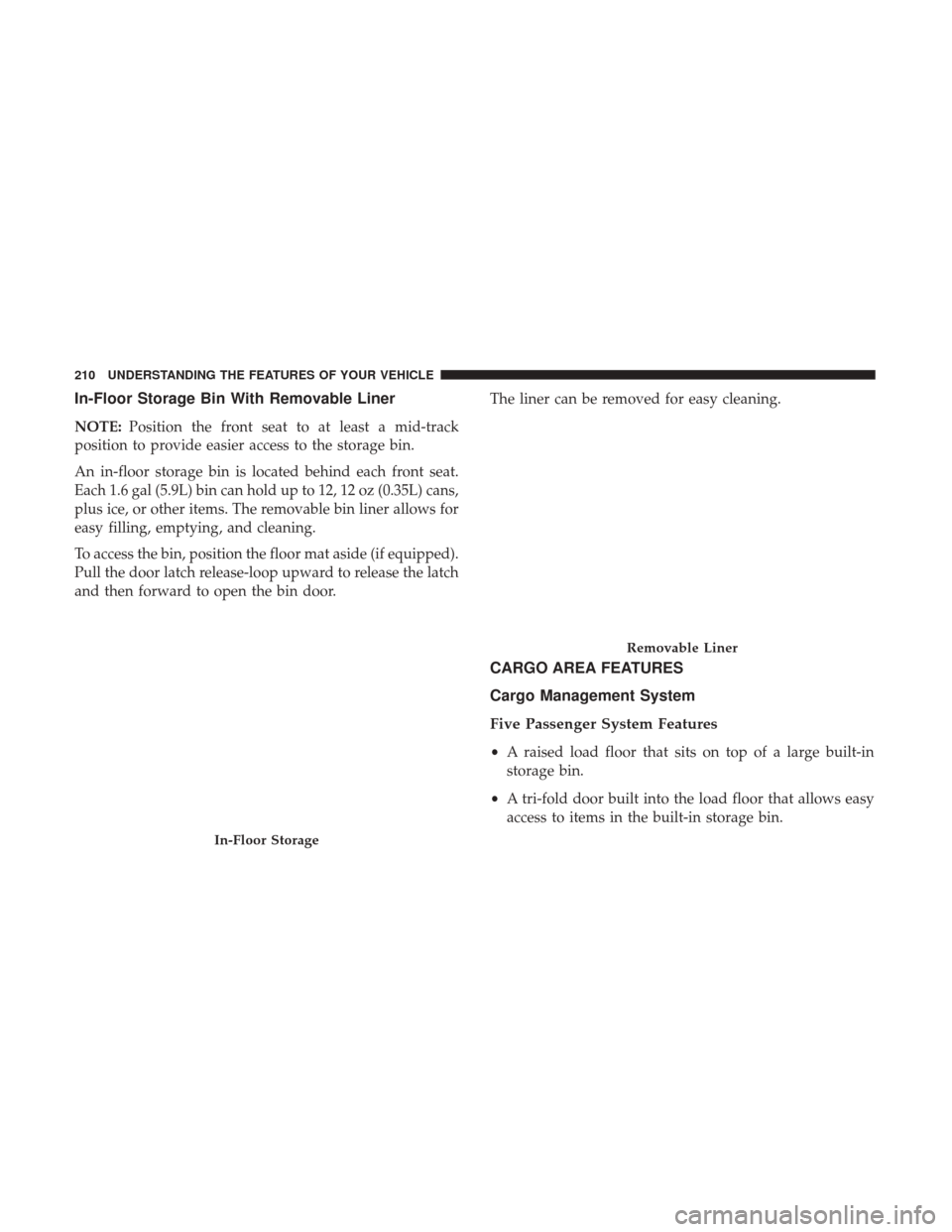
In-Floor Storage Bin With Removable Liner
NOTE:Position the front seat to at least a mid-track
position to provide easier access to the storage bin.
An in-floor storage bin is located behind each front seat.
Each 1.6 gal (5.9L) bin can hold up to 12, 12 oz (0.35L) cans,
plus ice, or other items. The removable bin liner allows for
easy filling, emptying, and cleaning.
To access the bin, position the floor mat aside (if equipped).
Pull the door latch release-loop upward to release the latch
and then forward to open the bin door. The liner can be removed for easy cleaning.
CARGO AREA FEATURES
Cargo Management System
Five Passenger System Features
•
A raised load floor that sits on top of a large built-in
storage bin.
• A tri-fold door built into the load floor that allows easy
access to items in the built-in storage bin.
In-Floor Storage
Removable Liner
210 UNDERSTANDING THE FEATURES OF YOUR VEHICLE
Page 213 of 510
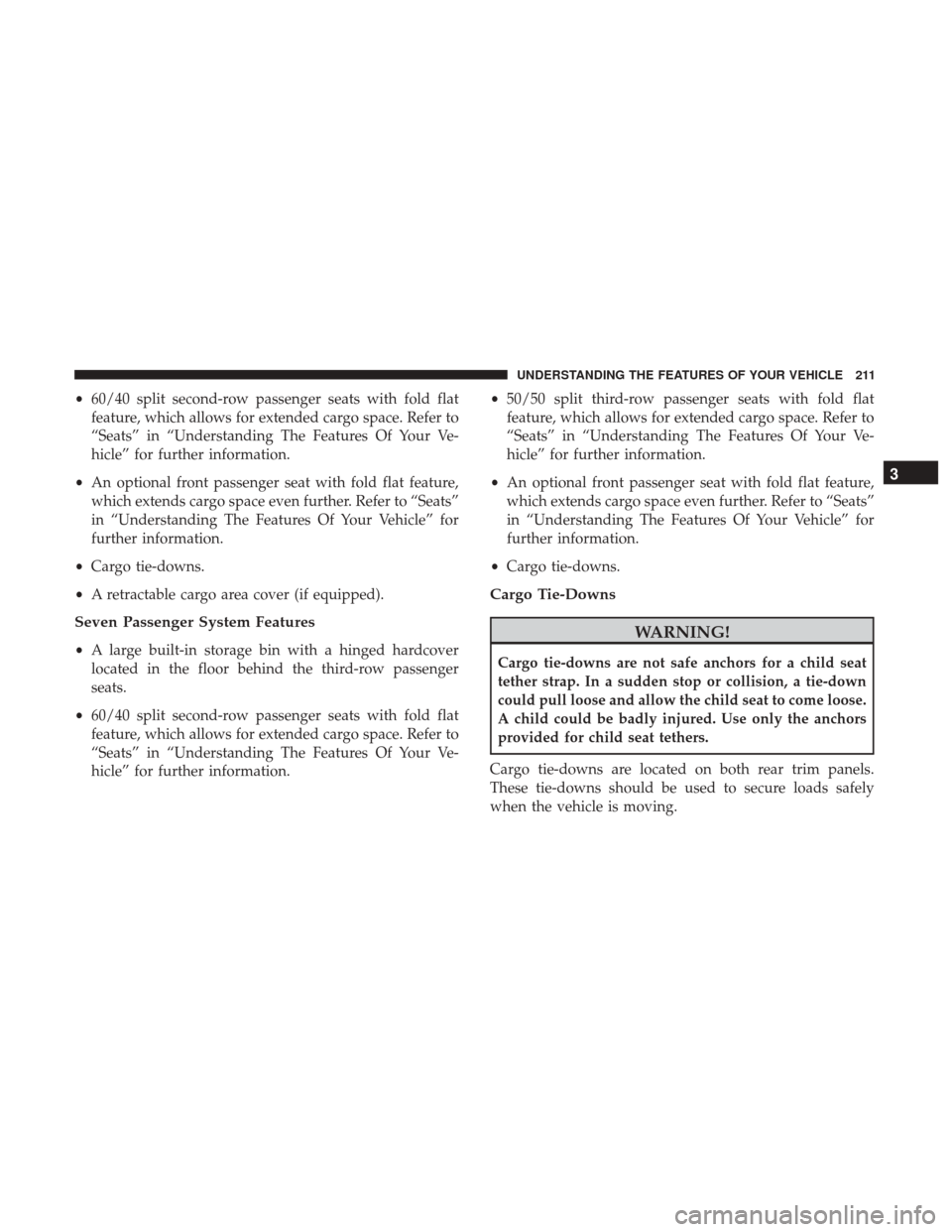
•60/40 split second-row passenger seats with fold flat
feature, which allows for extended cargo space. Refer to
“Seats” in “Understanding The Features Of Your Ve-
hicle” for further information.
• An optional front passenger seat with fold flat feature,
which extends cargo space even further. Refer to “Seats”
in “Understanding The Features Of Your Vehicle” for
further information.
• Cargo tie-downs.
• A retractable cargo area cover (if equipped).
Seven Passenger System Features
•A large built-in storage bin with a hinged hardcover
located in the floor behind the third-row passenger
seats.
• 60/40 split second-row passenger seats with fold flat
feature, which allows for extended cargo space. Refer to
“Seats” in “Understanding The Features Of Your Ve-
hicle” for further information. •
50/50 split third-row passenger seats with fold flat
feature, which allows for extended cargo space. Refer to
“Seats” in “Understanding The Features Of Your Ve-
hicle” for further information.
• An optional front passenger seat with fold flat feature,
which extends cargo space even further. Refer to “Seats”
in “Understanding The Features Of Your Vehicle” for
further information.
• Cargo tie-downs.
Cargo Tie-Downs
WARNING!
Cargo tie-downs are not safe anchors for a child seat
tether strap. In a sudden stop or collision, a tie-down
could pull loose and allow the child seat to come loose.
A child could be badly injured. Use only the anchors
provided for child seat tethers.
Cargo tie-downs are located on both rear trim panels.
These tie-downs should be used to secure loads safely
when the vehicle is moving.
3
UNDERSTANDING THE FEATURES OF YOUR VEHICLE 211
Page 214 of 510

WARNING!
The weight and position of cargo and passengers can
change the vehicle center of gravity and vehicle han-
dling. To avoid loss of control resulting in personal
injury, follow these guidelines for loading your ve-
hicle:
• Do not carry loads that exceed the load limits described
on the label attached to the left door or left door center
pillar. •
Always place cargo evenly on the cargo floor. Put
heavier objects as low and as far forward as possible.
• Place as much cargo as possible in front of the rear axle.
Too much weight or improperly placed weight over or
behind the rear axle can cause the vehicle to sway.
• Do not pile luggage or cargo higher than the top of the
seatback. This could impair visibility or become a dan-
gerous projectile in a sudden stop or collision.
• To help protect against personal injury, passengers
should not be seated in the rear cargo area. The rear
cargo space is intended for load carrying purposes only,
not for passengers, who should sit in seats and use seat
belts.Retractable Cargo Area Cover (If Equipped) — Five
Passenger Models
NOTE: The purpose of this cover is for privacy, not to
secure loads. It will not prevent cargo from shifting or
protect passengers from loose cargo.
The removable retractable cargo area cover mounts in the
cargo area behind the top of the rear seats.
Cargo Tie-Downs
212 UNDERSTANDING THE FEATURES OF YOUR VEHICLE
Page 215 of 510
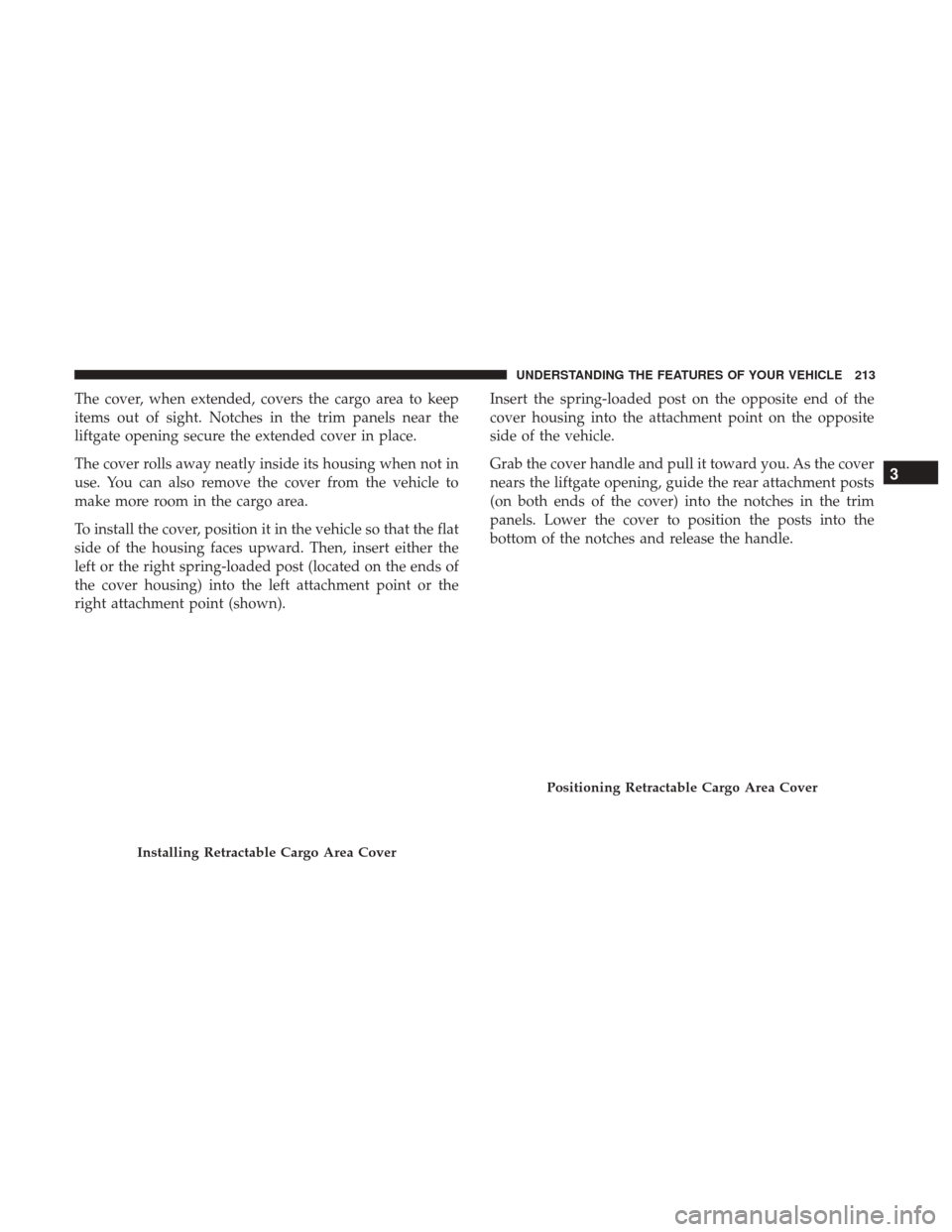
The cover, when extended, covers the cargo area to keep
items out of sight. Notches in the trim panels near the
liftgate opening secure the extended cover in place.
The cover rolls away neatly inside its housing when not in
use. You can also remove the cover from the vehicle to
make more room in the cargo area.
To install the cover, position it in the vehicle so that the flat
side of the housing faces upward. Then, insert either the
left or the right spring-loaded post (located on the ends of
the cover housing) into the left attachment point or the
right attachment point (shown).Insert the spring-loaded post on the opposite end of the
cover housing into the attachment point on the opposite
side of the vehicle.
Grab the cover handle and pull it toward you. As the cover
nears the liftgate opening, guide the rear attachment posts
(on both ends of the cover) into the notches in the trim
panels. Lower the cover to position the posts into the
bottom of the notches and release the handle.
Installing Retractable Cargo Area Cover
Positioning Retractable Cargo Area Cover
3
UNDERSTANDING THE FEATURES OF YOUR VEHICLE 213
Page 216 of 510
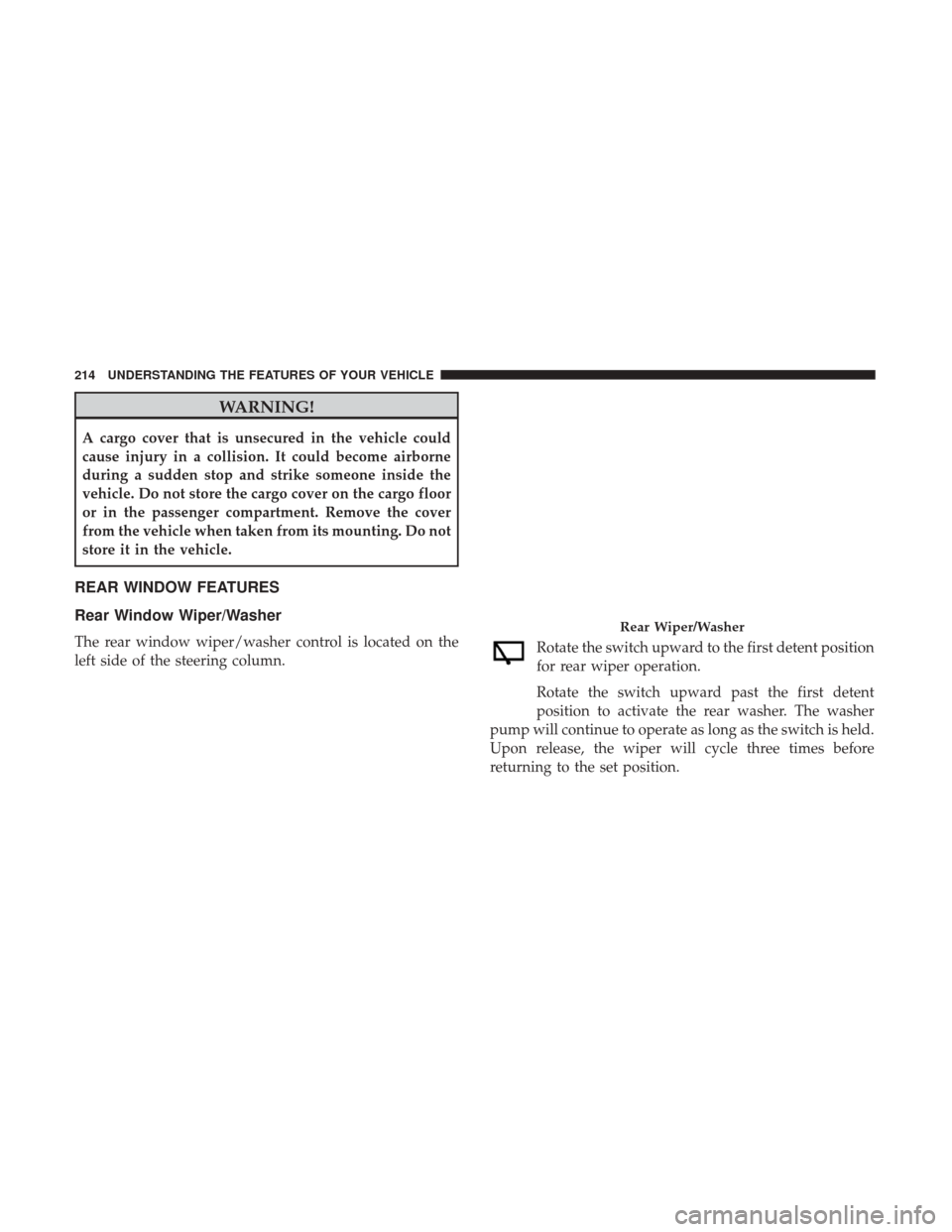
WARNING!
A cargo cover that is unsecured in the vehicle could
cause injury in a collision. It could become airborne
during a sudden stop and strike someone inside the
vehicle. Do not store the cargo cover on the cargo floor
or in the passenger compartment. Remove the cover
from the vehicle when taken from its mounting. Do not
store it in the vehicle.
REAR WINDOW FEATURES
Rear Window Wiper/Washer
The rear window wiper/washer control is located on the
left side of the steering column.Rotate the switch upward to the first detent position
for rear wiper operation.
Rotate the switch upward past the first detent
position to activate the rear washer. The washer
pump will continue to operate as long as the switch is held.
Upon release, the wiper will cycle three times before
returning to the set position.Rear Wiper/Washer
214 UNDERSTANDING THE FEATURES OF YOUR VEHICLE
Page 217 of 510
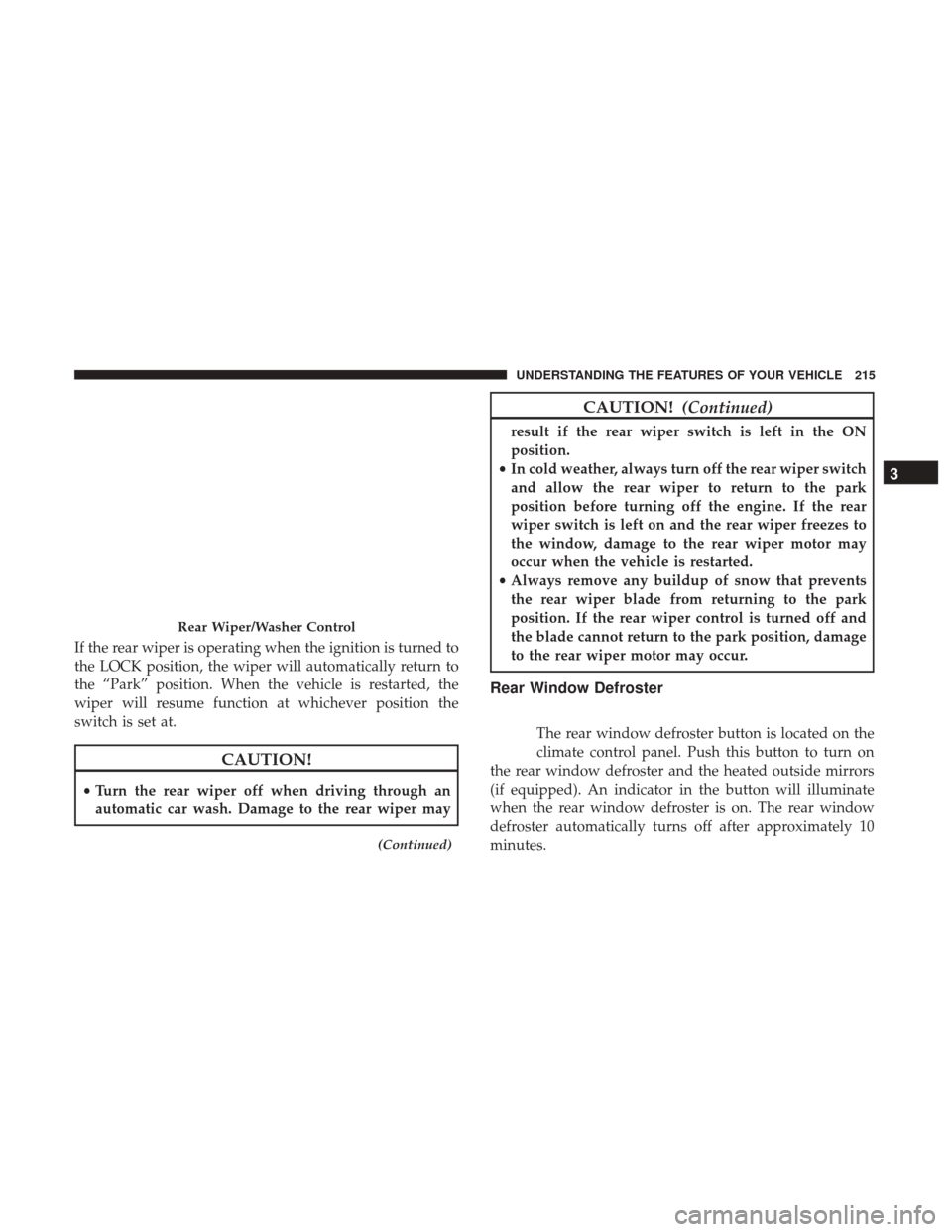
If the rear wiper is operating when the ignition is turned to
the LOCK position, the wiper will automatically return to
the “Park” position. When the vehicle is restarted, the
wiper will resume function at whichever position the
switch is set at.
CAUTION!
•Turn the rear wiper off when driving through an
automatic car wash. Damage to the rear wiper may
(Continued)
CAUTION! (Continued)
result if the rear wiper switch is left in the ON
position.
• In cold weather, always turn off the rear wiper switch
and allow the rear wiper to return to the park
position before turning off the engine. If the rear
wiper switch is left on and the rear wiper freezes to
the window, damage to the rear wiper motor may
occur when the vehicle is restarted.
• Always remove any buildup of snow that prevents
the rear wiper blade from returning to the park
position. If the rear wiper control is turned off and
the blade cannot return to the park position, damage
to the rear wiper motor may occur.
Rear Window Defroster
The rear window defroster button is located on the
climate control panel. Push this button to turn on
the rear window defroster and the heated outside mirrors
(if equipped). An indicator in the button will illuminate
when the rear window defroster is on. The rear window
defroster automatically turns off after approximately 10
minutes.
Rear Wiper/Washer Control
3
UNDERSTANDING THE FEATURES OF YOUR VEHICLE 215
Page 218 of 510

NOTE:To prevent excessive battery drain, use the rear
window defroster only when the engine is operating.
CAUTION!
Failure to follow these cautions can cause damage to
the heating elements:
• Use care when washing the inside of the rear win-
dow. Do not use abrasive window cleaners on the
interior surface of the window. Use a soft cloth and a
mild washing solution, wiping parallel to the heat-
ing elements. Labels can be peeled off after soaking
with warm water.
• Do not use scrapers, sharp instruments, or abrasive
window cleaners on the interior surface of the win-
dow.
• Keep all objects a safe distance from the window.
ROOF LUGGAGE RACK — IF EQUIPPED
The roof rack cross rails and side rails are designed to carry
cargo weight. The load must not exceed 150 lbs (68 kg), and
it should be distributed uniformly over the cross rails. In
addition, the roof rack does not increase the total load
carrying capacity of the vehicle. Be sure the total load of
cargo inside the vehicle plus that on the roof rack does not
exceed the maximum vehicle load capacity.
NOTE: The roof rack side rails on your vehicle are NOT
designed to carry a load without the addition of crossbars.
Metal crossbars are offered by MOPAR accessories to
provide a functional roof rack system. See your authorized
dealer.
To Move The Crossbars
1. Loosen the knobs on top of each crossbar approximately six turns to disengage the clamp tooth from the side rail.
216 UNDERSTANDING THE FEATURES OF YOUR VEHICLE
Page 219 of 510
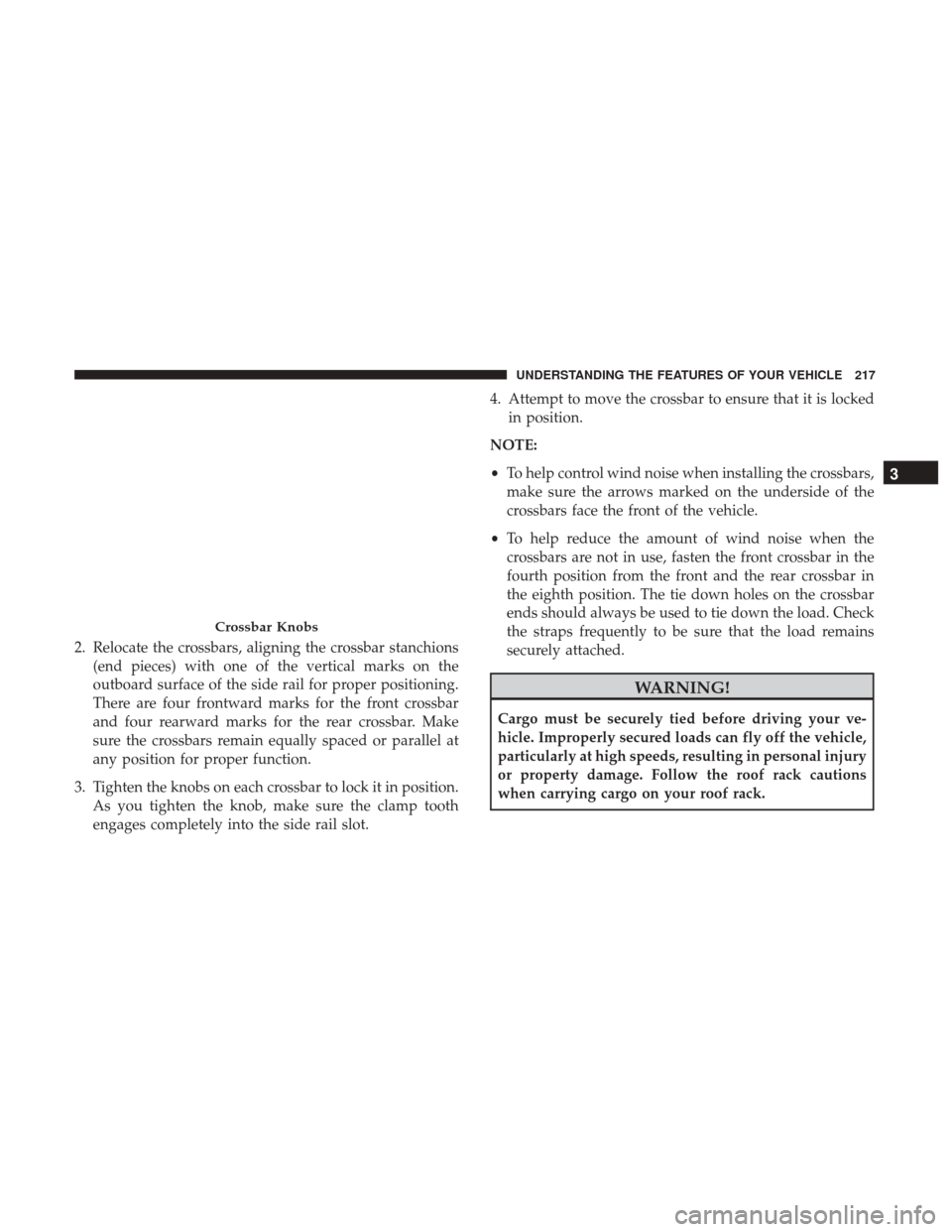
2. Relocate the crossbars, aligning the crossbar stanchions(end pieces) with one of the vertical marks on the
outboard surface of the side rail for proper positioning.
There are four frontward marks for the front crossbar
and four rearward marks for the rear crossbar. Make
sure the crossbars remain equally spaced or parallel at
any position for proper function.
3. Tighten the knobs on each crossbar to lock it in position. As you tighten the knob, make sure the clamp tooth
engages completely into the side rail slot. 4. Attempt to move the crossbar to ensure that it is locked
in position.
NOTE:
• To help control wind noise when installing the crossbars,
make sure the arrows marked on the underside of the
crossbars face the front of the vehicle.
• To help reduce the amount of wind noise when the
crossbars are not in use, fasten the front crossbar in the
fourth position from the front and the rear crossbar in
the eighth position. The tie down holes on the crossbar
ends should always be used to tie down the load. Check
the straps frequently to be sure that the load remains
securely attached.
WARNING!
Cargo must be securely tied before driving your ve-
hicle. Improperly secured loads can fly off the vehicle,
particularly at high speeds, resulting in personal injury
or property damage. Follow the roof rack cautions
when carrying cargo on your roof rack.
Crossbar Knobs
3
UNDERSTANDING THE FEATURES OF YOUR VEHICLE 217
Page 220 of 510

CAUTION!
•To prevent damage to the roof of your vehicle, DO
NOT carry any loads on the roof rack without the
crossbars installed. The load should be secured and
placed on top of the crossbars, not directly on the
roof. If it is necessary to place the load on the roof,
place a blanket or other protective layer between the
load and the roof surface.
• Crossbars should remain equally spaced or parallel
at any roof rack position for proper function. Non-
compliance could result in damage to the roof rack,
cargo, and vehicle.
• To avoid damage to the roof rack and vehicle, do not
exceed the maximum roof rack load capacity of 150 lb
(68 kg). Always distribute heavy loads as evenly as
possible and secure the load appropriately.
• Long loads, which extend over the windshield, such
as wood panels or surfboards, should be secured to
both the front and rear of the vehicle.
(Continued)
CAUTION! (Continued)
•Travel at reduced speeds and turn corners carefully
when carrying large or heavy loads on the roof rack.
Wind forces, due to natural causes or nearby truck
traffic, can add sudden upward loads. This is espe-
cially true on large flat loads and may result in
damage to the cargo or your vehicle.
218 UNDERSTANDING THE FEATURES OF YOUR VEHICLE